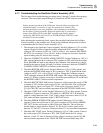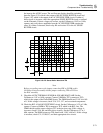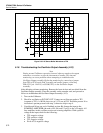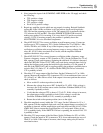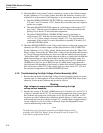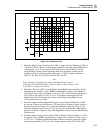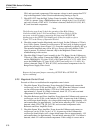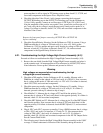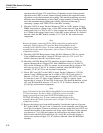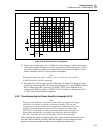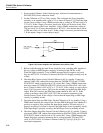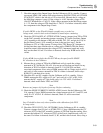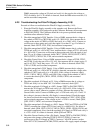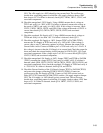
Troubleshooting
Component-level Troubleshooting
5
5-77
power up there is still no signal at TP3 during power up then check U3, U7C/D, and
associated components in the Square Wave Amplifier circuit.
4. Check the Absolute Value Circuit. Add a jumper connecting the front panel
OUTPUT HI binding post to the OUTPUT LO binding post. Set the Calibrator to
1.0A at 1 kHz, operate. Connect an oscilloscope to G OUT(pin 12C of P612) and
Note the amplitude of the positive wave peaks. Next, connect the oscilloscope to U2
pin 7 and verify the dc voltage is equal the previously Noted positive peaks of ac
voltage. If a failure is detected, check U2A, U2B, and associated components in the
Absolute Value Circuit.
Note
Remove the front panel jumper connecting OUTPUT HI to OUTPUT LO
before continuing.
5. Check the Signal/Polarity Selection. Set the Calibrator to 220V dc operate. Using a
DMM measure the dc voltage at TP4 and verify it is +6 to +8V. Next, set the
Calibrator to -220V dc operate and again verify that the dc voltage at TP4 remains
between +6 and +8V. If a failure is detected, check U2C, U6, and associated
components in the Signal/Polarity Selection circuit.
5-21. Troubleshooting the High Voltage/High Current Assembly (A15)
Proceed as follows to troubleshoot the High Voltage/High Current Assembly (A15):
1. Remove the rear shield from the High Voltage/High Current assembly and place it
on the extender card. All measurements will be referenced to ACOM (TP7) unless
Noted otherwise. Power up the Calibrator and proceed as follows.
Warning
High voltages are exposed when troubleshooting the high
voltage/high current assembly.
2. Check the ±20S supplies. Set the Calibrator to 0V dc, standby. Measure with a
DMM the dc voltage at the cathode of VR3 and verify it is 20V±5%. Next, measure
the dc voltage at the anode of VR4 and verify it is -20V ±5%. If a failure is detected,
check VR3, VR4, and associated components.
3. Check the power-up standby voltages. Set the Calibrator to 0V standby. Using a
DMM measure the dc voltage at TP5 and verify it is 0V ±50 µV. If a failure is
detected, proceed with step 4, otherwise skip to step 6.
4. Check Buffer U1. Measure the dc voltage at TP3 and Note the polarity. Next,
measure the dc voltage at TP5 and verify that it is the opposite polarity. If a failure is
detected, check U1 and associated components.
5. Check the HR7 Hybrid and U2. Measure the dc voltage at pin 10 of the HR7 Hybrid
and Note the polarity. Next, measure the dc voltage at TP3 and check that it is the
opposite polarity. If a failure is detected, check the HR7 Hybrid, U2, and associated
components.
6. Check -SP C and +SP C at power up standby. Using a DMM, measure the dc voltage
at TP4 (-SP C) and verify it is between +13.2 and +14.2V. Next measure the dc
voltage at TP6 (+SP C) and verify it is between-0.1 and -0.3V. If a failure is
detected, check Q3, Q4, Q6, and associated components in the HV DC Output Series
Pass & Current Limit circuit.
7. The following step 8 checks the High Voltage/High Current assembly in the 1100V
ac range. To better understand of function of this assembly during this mode of



